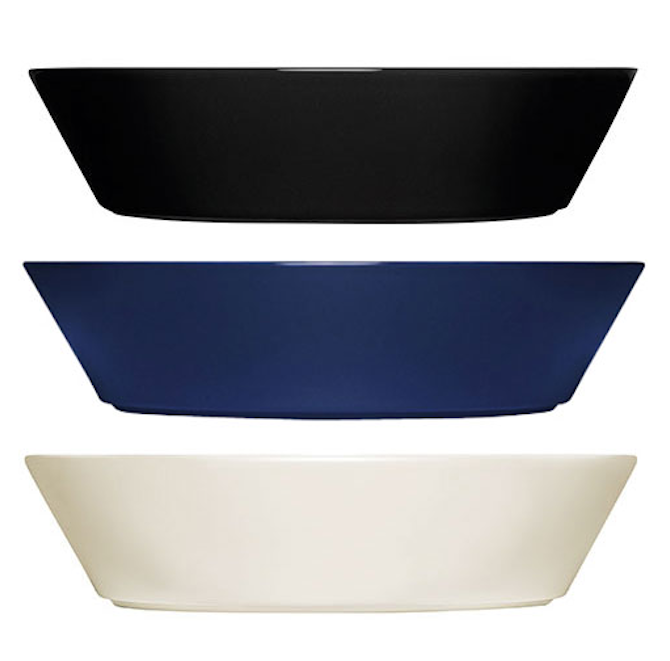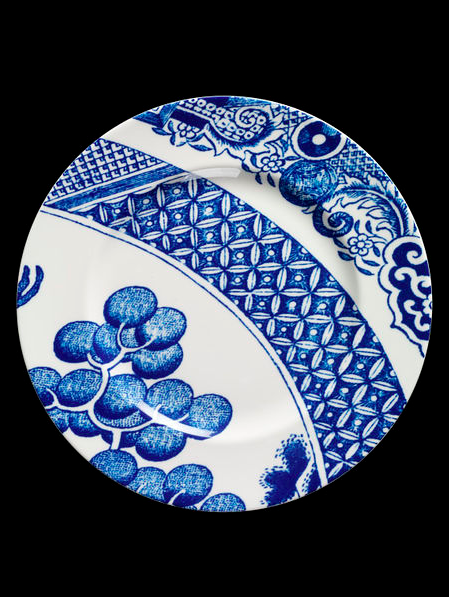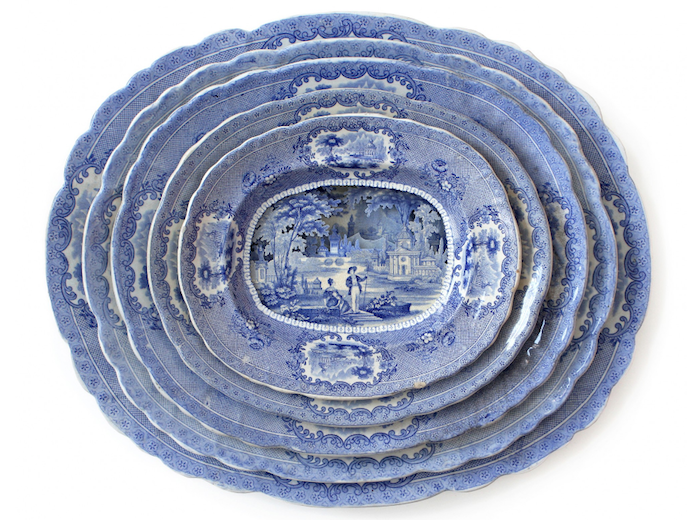
Kaj Franck’s Kilta, the stackable Lego of the dinner table, is now more than sixty years old. Franck, a young Finnish designer, intended his new work to be timeless, anti-hierarchical, and universal when he designed the dinner service in 1948. But even a plate has a past, and Kilta’s past is quite specific: the earthenware dinner series, issued by Arabia in 1952, went on to become one of the Helsinki-based firm’s best-selling tableware series. Kilta’s appeal when it was first marketed was not just the freshness and clarity of Franck’s design, but also the allure of a post-Enlightenment approach to eating. When Kilta is used as it was intended, the vessels serve only as tools for the storage and conveyance of food, rather than signaling allegiance to particular social rituals or traditions.
Unlike traditional European-designed dinnerware, Kilta’s plates and bowls are not ornamented. Not even the slightest cheerful posey or decorative fleur-de-lis peeps from the rigid geometry of Franck’s cups. In shunning European decorative traditions, Franck intended to empower the postwar consumer: the informal, interchangeable pieces could be assembled at will to serve the needs of the present. The plainness and affordability of the popular dinner service was intended as an erasure of pretention, history, and tradition. In the 1950s, Kilta offered European consumers a way to move forward, to forget the total devastation of recent years, if only in the act of setting the table.
Unlike traditional European-designed dinnerware, Kilta’s plates and bowls are not ornamented. Not even the slightest cheerful posey or decorative fleur-de-lis peeps from the rigid geometry of Franck’s cups. In shunning European decorative traditions, Franck intended to empower the postwar consumer: the informal, interchangeable pieces could be assembled at will to serve the needs of the present. The plainness and affordability of the popular dinner service was intended as an erasure of pretention, history, and tradition. In the 1950s, Kilta offered European consumers a way to move forward, to forget the total devastation of recent years, if only in the act of setting the table.

Like Lego—the bright plastic bricks which emerged from neighboring Denmark in 1954—Kilta was not only playful but also wordless. New owners shaped their own tabletop narrative by juxtaposing the pieces with pre-existing dinnerware, or by creating unexpected compositions of the series’ original colors: black, white, green, yellow, and turquoise. Cork lids punctuated a few storage vessels and a bamboo handle graced a tureen, but otherwise all the pieces were simple circles and squares covered with a single-fire glaze. The pieces which made up the Kilta service can still be used in a variety of ways. A small plate can double as a saucer, while a larger one can be used as a serving platter. Stolid square dishes vary similarly in size and potential function. As a body of work, the series has been rightfully recognized as landmark design achievement: it is practical, functional tableware that serves a range of purposes and stacks compactly when not in use. (Franck’s design, slightly modified in the 1980s to conform with modernized production standards, is now sold by Iittala as Teema. The Teema shapes are nearly identical to those of Kilta, and available in a wider variety of colors—though the line fortunately has been spared the princess pink controversy which plagued Lego’s attempts to keep up with market expectations.)
For diners who dislike the visual experience of witnessing flora and fauna emerge from beneath their salad, Kilta/Teema continues to offer a welcomingly blank canvas from which to eat a meal. In fact, the plain geometry of both series heightens the aesthetic intensity of the object it presents, be it a cucumber slice or a Twinkie. (In case you are wondering, Twinkies were created in the Midwest in the early 1930s, making them older than both Lego and Kilta.)
For diners who dislike the visual experience of witnessing flora and fauna emerge from beneath their salad, Kilta/Teema continues to offer a welcomingly blank canvas from which to eat a meal. In fact, the plain geometry of both series heightens the aesthetic intensity of the object it presents, be it a cucumber slice or a Twinkie. (In case you are wondering, Twinkies were created in the Midwest in the early 1930s, making them older than both Lego and Kilta.)
The simple satisfaction of assembling meals on these playful, functional forms may explain the series’ durable appeal in the years since its first issue. The way in which Teema’s plain ceramic backdrop focuses the eater’s attention on food may also resonate particularly well today, when there is increased self-consciousness about the ways that food choices serve as potent markers of personal identity. Yet the question of time and history remains as complicated as the series was first issued. The original name for the series, Kilta, which is Finnish for “guild,” undermined Franck’s claim of timelessness from the outset. (The current name, Teema, means simply “theme.”) Instead of looking directly to the future, as Arabia’s marketer’s claimed, the series already contained at least two layers of nostalgia. Interwar design reformers like Peter Behrens and Walter Gropius had called for modern designers to heed the lessons of medieval craft collaboration in designing new products for Weimar Germany, and William Morris made similar claims in leading the British Arts and Crafts movement. Trained as a furniture designer, Franck would have been intimately familiar with both movements. He also would also, of course, have known that medieval society was marked with its own irrational traditions and hierarchies. However deliberately ahistorical the Kilta plates and cups may appear, Franck’s adherence to design principles articulated well before the Second World undermined his claim that Kilta looked only to the needs of the present. Perhaps Franck just liked contradiction: the functionalist designer was caught in at least one publicity photo wearing suspenders and a belt.
Today, Kilta is old enough to be inherited china—hardly the crated Meissen or cabbage rose tea sets conjured up by the phrase. Yet the plates themselves give no hint of contradiction. The bowls hold tomato soup as well as they did in the 1950s; the larger mugs only hint at a new taste for oversized coffees. Whether hungry or thirsty, the diner can still use these cups and bowls without thinking about modernist rhetoric or inheritance.
The passage of time continues to be of essence at the dinner table. In a reversal of attitudes from Franck’s day, current ceramic artists and tableware designers are embracing the past with enthusiasm. A new conversation has emerged, with its own distinctive sense of playfulness—for, in fact, much of this new work is funny, but the play is not open-ended: designers are focusing the conversation on specific patterns, forms, and issues. Designers like London-based Robert Dawson and Helsinki’s Caroline Slotte are among an international cohort of artists who sample, distort, and redesign eighteenth- and nineteenth-century dinnerware patterns to create new works which can surprise and delight a generation raised on modernist seriousness. (Exhibitions of work in this vein include The New Blue and White at the MFA Boston and a forthcoming show at the Victoria and Albert Museum.)
Other contributors to the dialogue include Australian Robin Best, China’s Xue Lei, and the Stockholm-based collaborative Front, signaling a global interest in bringing back the past to the table. The best of the new work is intelligent, provoking viewers and users—for it is produced as both gallery installations and commercial tableware—to interrogate the history of European ceramic production and the global ceramic trade. The mood of most of this work, which began to appear in the 1990s, is irreverent and ironic, suggesting a critical detachment from the images of birds, bridges and boats, which float across its plates, cups and saucers. It is now almost cliché to design dinnerware which appropriates patterns from seventeenth- and eighteenth-century European dinnerware.
Even IKEA is finally in on the game—evidence, no doubt, that the movement may have come to its logical conclusion. The most compelling pieces in this new body of work raise valid questions about ceramic design and the role of tradition at the table. However, the new work frames a line of inquiry which is much more directed than Franck’s open-ended Kilta project. As in other areas of inquiry, universality has been abandoned; self-referential, intra-disciplinary work is prized.

Robert Dawson has produced some of the strongest commercial work of the new blue and white movement. In 2005, he was commissioned to design the After Willow series for Wedgwood. Priced slightly higher than Teema, the plates of After Willow feature fractured, distorted—yet eminently recognizable—patches of the blue and white Willow pattern, which appeared on so many British plates after 1800. The magnified scale of each fragment, as well as the unusual placement of the pattern on the plate, draws the diner’s attention to the narrative within a visual composition that is usually taken for granted. Dawson’s enlarged lovebirds hang in suspension on one plate; another plate’s Orientalized bridge seems like an exotic destination. Dawson’s work is a product of the present: his patterns are based on digital photographs of old patterns, which he is then able to manipulate digitally before transfer printing onto conventional bone china plates. Dawson calls his project “Aesthetic Sabotage.” Yet this title, like Kilta, is slightly misleading. Dawson may be distorting an original image, but he is tinkering with a pattern, rather than truly subverting a norm. The plate remains disrupted only on its surface.
After Willow dinnerware is sold by an established manufacturer to a discerning, if self-aware, audience. To employ After Willow at the dinner table is to signal a sophisticated appreciation for Dawson’s knowledge of British history as well as his insouciance. The social use of the series is not so far removed from that of the original Meissen, Sevres, or Wedgwood. Dawson’s tabletop narrative, like much of the work produced by the new blue and white artists, is focused on British history, the history of image exchange and object production within an industry. The plate itself does not change anything about the individual’s physical encounter with food. Dawson’s ironic, detached attitude is clever, but subtly prompts the user to follow the artist's line of thought, rather then inviting the user to open a new conversation.

Even more specific in her references to the past is Caroline Slotte, who creates assemblages from found china. Slotte’s delicately chiseled and cut scenes create tiny worlds into which the viewer may peer, an elegant ceramic version of the Fisher Price View-Master. Slotte’s work, which has not been produced commercially, is part of a broader investigation of everyday objects. Slotte believes that the traces of unknown users remain onplates, clothes and other twentieth-century detritus—and her project is part of a quest to draw attention to the traces left by everyday life. In most of her work, Slotte carefully gathers secondhand dinnerware, then etches, cuts, and carves away excess details until a single element, like a cloud or a church tower, is left behind. The ease with which viewers may recognize the missing elements of Slotte’s landscapes demonstrates how well the visual logic of a pattern like Willow is burned into a common visual literacy of the dinner table.
To see Slotte’s work, a viewer has to stand in a specific place; these are not works which can be used at the table. The traces which she excavates are of course imaginary, produced by Slotte’s own drilling, rather than the actual traces of individual diners—those people and their dreams, meals, and ideas remain stubbornly unknown. (Slotte has also done a series in which she experiments with the power of food residues to produce recognizable patterns on ordinary china.) Slotte is as present in her work as Franck intended to be absent from his. Her work is imperfect, incomplete, of a particular time; he intended his to be anonymous, flawless, and comprehensive.
More than four hundred years have passed since the British horticulturalist John Evelyn declared the arrangement of vegetables into a meal to be the process of “imparting order to chaos” (Acetaria, A Discourse of Sallets, 1699). Evelyn didn’t say anything about the plate. But like a canvas or a frame, a plate is a first enclosure of the raw materials which enter our bodies and fuel our days. The act of handling plates, bowls, and glasses is one of life’s most repetitive gestures: eat, wash, rinse, repeat. Where does the plate intervene in this ritual and does it matter whether that plate is plain or ornamented, paper, or gilt? The hungry would say no. And there’s no word for a discordance between a plate and a meal—for eating today’s microgreens on yesterday’s Meissen, or celebrating a milestone with drugstore Dixieware. But history, or at least personal history, is made of small repeated gestures, of tactile sensation, of ideas taking form over a meal. And so the plate should matter.
IKEA’s blue and white plates, which feature fragments of traditional designs interspersed with small hot air balloons, are clearly nonsense. Dawson, Slotte, and others raise good questions about the ceramic trade and the extent to which patterns and traditions can be manipulated to serve the whims of the present.
Franck’s Teema, like all abstraction, remains frustratingly mute. But like Godtfredt Kirk Christiansen’s original Lego (the word means "good play"), the circles and squares of Franck’s dishes and plates leave the conversation open.
